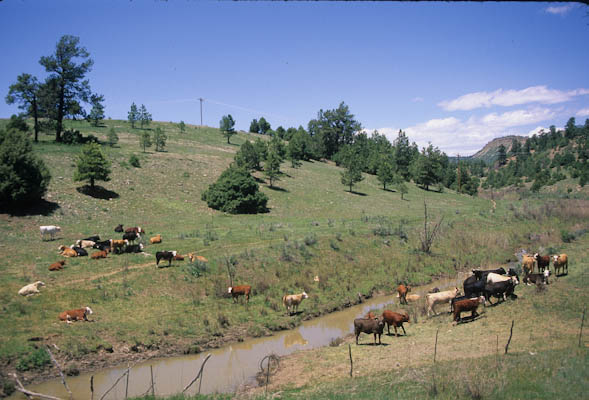
Cows in riparian areas by Chama New Mexico. Photo: George Wuerthner.
Rangelands make up a large proportion of the Earth’s surface, and the soils hold a significant amount of sequestered carbon (Schuman,G.E et al. 2001). Rangelands are estimated to contain more than one-third of the world’s above and below ground carbon reserves (Ingram L.J. et al. 2008). Agriculture, both livestock grazing and forage production of livestock feed are among the greatest use of US lands (Nickerson, Cynthia and Allison Borchers. 2012). Therefore, there is interest in determining the potential for soil carbon sequestration in rangeland soils, and whether livestock grazing helps or hinders this sequestration (McSherry, M., and Mark Richie. 2013).
Allan Savory has generated a significant amount of response based upon his TED talk where he claimed that increasing livestock grazing could reverse climate change (Savory, A. 2013)/
Though many question many of Savory’s assertions of successful livestock production and improvements in rangeland health (Wuerthner, George, 2002b; Jamus, Joseph et al., 2002; Briske, D. et al., 2013; Carter, J. et al. 2014; McGuire. Andrew 2018; Skovlin, Jon. 1987; Holechek, Jerry., 2000; Sundt, Peter. 2013).
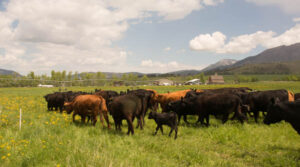
Savory and others grazing advocates allege that concentrations of cattle that are moved frequently will increase soil carbon sequestration. Cattle here grazing irrigated pasture, Paradise Valley, Montana. Photo George Wuerthner.
Recently Savory and others allege that “regenerative” grazing can sequester significant amounts of carbon, however, this assertion is also questioned. (Nobari. Massim 2018).
The potential for sequestering more carbon varies tremendously; however, based upon a number of factors including existing carbon storage (there is a finite amount of carbon that soils can hold before they are “saturated”), plant productivity, grazing management, and climate.
Annual rates of soil organic carbon (SOC) accumulation decline as the soil approaches equilibrium (Nordborg, 2016). Sometimes overly optimistic predictions result when SOC accumulations increase in the early years after a change in grazing management, but these increases cannot be extrapolated indefinitely (Powlson et al. 2014).
The issue of whether livestock grazing can sequester carbon in soils has gotten greater attention in recent years due to climate change issues (Beschta, R., D. L. Donahue, A. DellaSala et al. .2012),
Some proponents of livestock grazing assert that grazing can lead to the sequestering of significant amounts of carbon in soils and reduce GHG emissions (Savory, A. 2013).
In the most optimistic claims, some, like Allan Savory, suggest that livestock grazing can reduce carbon to pre-Industrial levels. In particular, Savory’s (Savory, A. and J. Butterfield,1999) unverified claims have generated a number of responses that dispute his assertions (Catlin, James C. et al. 2011, Carter, J. et al. 2014; Briske, D. et al. 2014; Chamane, Sindiso et al.2016; Hawkins, Heidi-Jayne. 2017).
While there may be circumstances under which grazing could increase carbon in the soil, most rangeland soils have a limited ability to store additional carbon, and under most conditions’ livestock grazing will reduce carbon storage rather than increase it.
Efforts to maintain and increase carbon storage in rangelands should focus on reducing livestock grazing in areas where it ecologically inappropriate and causing degradation. Those promoting the climate benefits of livestock grazing must account for effects beyond soil carbon. Livestock are a significant source of methane emissions, so increased methane emissions likely offset any speculative benefits from increased soil carbon storage.
There is a tremendous amount of carbon tied up in agricultural soils. The amount of carbon bound up in soils is approximately three times the amount of C found in above-ground biomass. The argument goes that a small increase in soil carbon pools could have a significant impact on the reduction of global GHG emissions.
The fundamental way that carbon is sequestered in the soil is by plant growth, primarily through roots, in the Earth, along with micro bacteria, soil microbes, and other soil life that can live on plant material.
Given the existing condition of many rangelands, the biggest concern is maintaining current carbon and avoiding losses through soil erosion, degradation of plant productivity, and other changes that lead to soil carbon losses. In other words, the best way to reduce CO2 emissions from rangelands globally is to reduce rangeland degradation. Since livestock grazing is frequently the primary source of rangeland degradation, as well as native vegetation conversion for cattle grazing (Kauffman 2017), a reduction in grazing pressure can potentially preserve more soil carbon in many ecosystems.
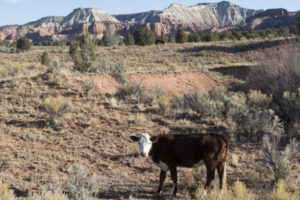
Cattle grazing of arid regions such as the Grand Staircase Escalante NM in Utah destroys biocrust which are critical for reducing soil erosion. Photo George Wuerthner.
The idea that “hoof action” and “herd effect” as prescribed by Allan Savory will increase water infiltration and carbon in soil has been challenged. When comparing land that was not grazed with the land managed using a short rotational grazing system (which is very similar to Holistic Management in its ideas), water infiltration was significantly reduced (Belsky, J.A et al. 1999). The hoof action did not improve the incorporation of litter into the soil (Dormaar et al. 1989, Holechek et al. 2000) and reduced soil biocrusts (Cooper et al. 2018).
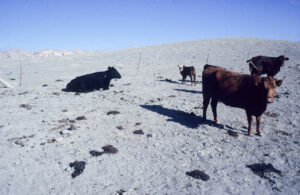
If you remove almost all the vegetation, you do reduce fire spread, but there is tremendous ecological damage as a consequence. Grand Staircase Escalante NM, Utah. Photo George Wuerthner.
Concentrated grazing is alleged to reduce fire spread. Targeted grazing which utilizes concentrated livestock grazing may reduce flame length and spread (Diamond, Joel, Christopher A. Call, and Nora Devoe. 2009), however, it also tends to destroy biocrusts and often reduces native grasses (Condon Lea and David Pyke. 2018).
While increasing soil carbon storage may be theoretically possible in some circumstances, soil’s ability to absorb carbon is limited. Many ecosystems are at or near equilibrium and cannot store additional carbon. To bind more carbon in the soil requires a continuous input of new organic matter. The soils with the best opportunities for extra carbon storage have been depleted by overgrazing and ecosystem degradation. Still, these landscapes frequently require a long period to recover. They are also the most difficult to recover (Sommer R. and D Brossio. 2014).
This gets into the time factor regarding global GHG emissions. Reducing emissions is more important now than in future decades. Due to the slow accumulation rate of carbon in soils, even if certain grazing practices could enhance carbon storage in some situations, the process may not help reduce global CO2 levels in a reasonable time frame.
By contrast, methane emissions from livestock are a significant contributor to GHG warming now, and these emissions are one of the easiest (relatively speaking) human anthropogenic sources of CO2 equivalents to reduce.
LIVESTOCK AS A SOURCE OF METHANE
Livestock are among the largest sources of global anthropogenic methane. Depending on which study is used, anywhere from 14-51% of the global GHG emissions in CO2 equivalences are due to livestock production (U.N. Livestock’s Long Shadow (Steinfeld, H. et al. 2006) or Climate Change and Livestock (Goodland, R Anhang, J, 2009). The U.S. EPA assigns one-third of anthropogenic methane emissions to livestock production—ahead of natural gas and petroleum systems as a source (Myers 2014).
Even if livestock grazing could generate some carbon sequestration over the long term (and as we shall see below, this is not a proven given), the presence of livestock emissions occurring in the interim would still be a significant problem (Ripple, W. et al., 2014). One would have to balance any carbon sequestration against methane emissions to see if livestock grazing were a net benefit (Hudak, 2015).
A study in China found that the uptake of CH4 (methane) by grassland soils only offset 3.1-8.6% of methane emissions from grazing sheep (Wang, x., et al. 2015). This suggests that even if livestock grazing could promote methane sequestration, it would not be significant to outweigh the emissions resulting from livestock digestion.
One problem to keep in mind is that methane is 84 to 86 times more effective than CO2 in trapping heat during the first 20 years after its release into the atmosphere (IPCC, Fifth Report, 2013.) (Over a 100-year time scale, methane breaks down into CO2; the IPCC currently considers methane to be approximately 28 to 34 times more effective than CO2 in trapping heat over the 100-year time scale.) Since reducing global heating is a priority now, not 100 years from now, the more effective heat-trapping properties of methane in the first decade or two after emission make it especially dangerous.
VARIATION IN CARBON STORAGE
When viewing the contribution that livestock grazing may make to carbon sequestration, a few other considerations must be part of an informed decision (Booker, Kayle et al., 2013).
The first is that there is tremendous variation in reported soil carbon storage due to variation in ecosystems, grazing methods and management, the soil profile and depth analyzed, study duration, grass type, and precipitation. Accounting for this variation is context-based and makes comparative statements difficult (Mcsheery M. and Mark Richie. 2013).
GRAZING INFLUENCES ON SOIL CARBON STORAGE
Grazing can affect carbon storage losses by shifting plant species dominance in some communities. In ecosystems, where heavy grazing by native ungulates was historically common (like the Great Plains), soil carbon sequestration is facilitated by a shift in plant species.
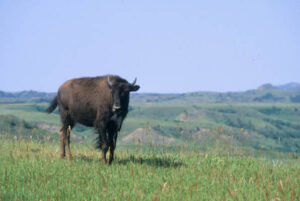
In native grasslands such as on the shortgrass Great Plains, grazing by mobile native ungulates like bison has resulted in grasses tolerant of heavy grazing like blue gramma. Bison at Theodore Roosevelt NP, ND. Photo George Wuerthner.
For example, a long-term study of the Northern Great Plains in North Dakota found that moderate grazing resulted in 17% less soil carbon sequestered than in ungrazed exclosures; however, heavy grazing resulted in a shift towards blue grama, a grazing tolerant species with shallow, but dense roots. The dominance by blue grama resulted in sequestered soil carbon levels like those found in the ungrazed exclosure (Frank, A.B. et al. 1995). However, this increase in soil carbon due to heavy grazing of blue grama occurred only in the shallowest soil layers where it is more vulnerable to loss.
A similar situation was found in a study of alpine meadows in China, where medium to heavy grazing increased soil carbon in the topsoil layers due to a shift in plant species to grasses tolerant of heavy grazing. These grasses have dense roots, thereby increasing soil organic carbon (Gao. Y.H. et al. 2007).
Even where a shift in plant species dominance may appear to improve soil carbon storage potential, there is a significant variation in sequestration rates due to the influence of other climate variables, such as drought and increased soil temperature.
Talore et al. 2015 in a study in South Africa that included a 75-year grazing exclusion, concluded that grazing treatments reduced soil organic C (SOC) stocks and C:N ratios, and modified soil properties. There was higher soil organic carbon in the enclosure than in spring grazing, summer grazing and winter grazing.
Carter et. al. 2014 in a review of Savory Holistic Management (HM) grazing methods and his assertion that livestock grazing would significantly contribute to less Greenhouse Gas Emissions concluded: Ecologically, the application of HM principles of trampling and intensive foraging are as detrimental to plants, soils, water storage, and plant productivity as are conventional grazing systems. Contrary to claims made that HM will reverse climate change, the scientific evidence is that global greenhouse gas emissions are vastly larger than the capacity of worldwide grasslands and deserts to store the carbon emitted each year.
A study in a mixed-grass ecosystem on the Great Plains found that heavy grazing (50 percent utilization) over ten years resulted in a 30% loss in soil organic carbon (SOC). This was a consequence of shifting plant dominance from mixed prairie grasses to blue grama, a grass that tolerates heavy grazing. Blue grama has dense but shallow roots; thus, SOC accumulates closer to the surface where it is more easily lost (LeCain et al. 2004).
Under drought conditions, gradually increasing soil temperatures, and heavy grazing, the blue grama root system could not retain carbon accumulated under the previous decade’s wetter, cooler-soil conditions. (Interestingly, this study also documented that there was little change in SOC in the no grazing and light grazing [10 percent utilization] treatment areas over this same dry, warmer-soil period. It also documented that increases in total nitrogen accumulated in the no grazing and light grazing treatments over this period while nitrogen stores declined in the heavy grazing treatments (Ingram, LJ. Et al. 2008).
Climatic influences are more likely to affect shallow SOC deposits like those found in blue grama grasslands. For instance, another study on the Great Plains found that carbon storage by cool-season grasses improved in a wet year, and there was greater carbon storage in an exclosure. In contrast, the following year, a grazed pasture dominated by blue grama had a higher CO2 exchange rate (LeCain et al. 2004 ).
This variability in results also points out the danger of short-term studies that are the most common in the research world. Depending on the year’s climatic conditions, the measurements recorded can significantly influence the findings and conclusions.
Many of the studies of soil carbon storage have been done in ecosystems where there was significant evolutionary grazing influence from native species such as bison like on the Great Plains, which may bias conclusions. In these areas, plants exist that have developed a tolerance for heavy grazing.
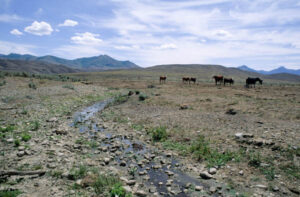
Much of the arid West, especially the Great Basin, evolved in the absence of large herds of grazing animals and are intolerant of heavy grazing pressure from livestock. Near the Ruby Mountains, Nevada. Photo George Wuerthner.
In contrast, in areas where native grazers were less abundant (like the Great Basin and many desert areas), plants’ ability to adapt to livestock grazing appears to be less resilient (Mack and Thomas, 1982). However, there have far fewer studies conducted grazing influence on soil carbon in these ecosystems.
One study in SE Utah found areas used by domestic livestock have 20% less plant cover and 100% less soil organic carbon and nitrogen compared to relict sites browsed by native ungulates (Fernandez, D.P, J.C. Neff, R.L. 2008).
Livestock grazing is the primary factor in tipping some ecosystems over ecological thresholds such as the Great Basin’s rangelands (Bradley BA, et. al 2017). For instance, exotic, shallow-rooted cheatgrass has replaced deep-rooted native bunchgrasses and shrubs on some western rangelands. Cheatgrass sequesters very little carbon and increases the SOC rate of turnover (Meyers, S. 2011).
As the author notes, “The elimination of perennial understory vegetation and cryptobiotic crusts is a nearly inevitable consequence of livestock grazing in deserts. This opens these systems to annual grass invasion, subsequent burning, and loss of a major carbon sink, a heavy price to pay for the minimal economic gains derived from direct use of these intrinsically unproductive lands for livestock production”( Meyers, S. 2011).
Changing disturbance intensity (grazing) in an ecosystem with low disturbance regimes can lead to a cascade of events. One study found that photosynthesis decreased after a shift to high disturbance, followed by a decline in root biomass and a change in plant community structure 1.5 months later. Those changes led to a decrease of soil fungi, a proliferation of Gram(+) bacteria, and accelerated decomposition of old particulate organic C (<6 months). At last, accelerated decay released plant-available nitrogen and decreased soil C storage. The results indicate that intensified grazing triggers the proliferation of Gram(+) bacteria and subsequent faster decomposition by reducing roots adapted to low disturbance (Klumpp, K., Fontaine, S., Attard, E., Le Roux, X., Gleixner, G. and Soussana, J.-F. (2009).
A study in China found that grazing exclusion resulted in greater above-ground biomass, root biomass, and plant litter than grazed grasslands (Wang, x. et al. 2015). Grazing exclusion significantly increased C and N stored in plant biomass and litter and increased the concentrations and stocks of C and N in soils. Furthermore, these differences were accentuated the more extended grazing was excluded with the highest C and N stocks in a 17-year grazer excluded grassland (Qiu, L. et al. 2013).
In another study in China, variation in precipitation had a more significant effect on carbon uptake and release. The ungrazed plots had less variation, and the authors concluded that ungrazed lands might have more resistance to changing climate (Shao, C. et al. 2013).
A third study in China’s Inner Mongolia found the standing dead plant. Litter carbon (C) decreased significantly in light grazing conditions (when compared to a non-grazed exclosure that had been fenced for 26 years). Still, light grazing did not significantly affect live plant C, total above-ground plant C, total root C (0–60 cm), and soil C (at 0-100-cm depths). Heavy grazing extensively reduced carbon in three pools, total above-ground plant C, subsoil C (at 60–100 cm), and total soil C (at 0–100 cm), but did not affect topsoil C (at 0–60 cm). The lack of an effect on topsoil C can be explained by a slight increase in root C (0–60 cm) and a higher root ratio to vegetation C in the heavy grazing site. The decrease in subsoil C under heavy grazing is attributable to the organic carbon decomposition due to increased root C as a new carbon source. Total ecosystem C decreased from 150.62 Mg C/ha in the N.X. site to 143.78 Mg C/ha in the L.G. site (a 4.5% decrease) and to 122.43 Mg C/ha in the H.G. site, an 18.7% decrease (Fang Fei, Chang Rui-ying1, Tang Hai-ping 2014).
Similarly, in a fourth study of the Loess Plateau in China, a twenty-year exclusion of livestock grazing significantly increased above and below-ground biomass, species richness, cover, and height for five different communities. The authors concluded that “long-term exclusion of livestock grazing can significantly improve typical steppe properties in the Loess Plateau (Cheng, J. et al. 2011).
The point of all conflicting results is that one cannot generalize and always assume that grazing will increase soil carbon stocks. Clearly, in many areas, grazing exclusion is the best way to store and even increase soil carbon (Dingpeng Xionga, Peili Shia, Xianzhou Zhanga, Chris B. Zou. 2016).
Briske and colleagues question how much carbon can be sequestered in rangelands in general, due to the low productivity of rangelands ecosystems. As they note, rangelands are known to be very weak sinks for atmospheric C because plant production in water-limited, and more C is often released into the atmosphere from soil respiration than is taken up by vegetation, especially during drought periods (Briske, D. et al. 2013).
Zhang, Yi et al. 2019 concluded that fencing and no grazing cause the slow diffusion of carbon to greater soil depths, even after 30 years of cattle exclusion.
Bao-Long, Yan et. el. 2018, found for all increments along with the soil profile, enclosure significantly increased BGB (below-ground biomass) and soil C density compared to grazing plots in TS (typical steppe), but this effect was not found in DS (Desert Steppe). (4) Enclosure increased C density of the plant-soil system by 2.2 and 1.6 times in TS and DS, respectively. 65% and 89% C was stored in soil in TS and DS, respectively, and BGB C stock accounted for more than 90% of total biomass C in both TS and DS. Enclosure is an effective approach to improve C sequestration in grassland ecosystems.
Daryantoa et al. 2013 found that destocking currently grazed shrublands in Australia for two decades resulted in a net C accretion, over 20 years, in the order of 6.5 Mg ha−1, almost entirely through increasing belowground C.
A further complicating matter is how vegetation affects soil carbon storage. For instance, under heavy grazing in the Great Plains, blue grama, a sod-forming grass very resistant to grazing, tends to increase. Blue grama roots are denser and found in shallower soil profiles than other grasses. Hence, soil carbon measurements can be affected by the dominant species, and the depth of soil profiles examined. Heavy grazing may increase soil carbon in the Great Plains by favoring blue grama but at the expense of a greater diversity of deep-rooted grasses (Ingram L.J. et al. 2008).
Derner, et al., 2018, however, were not able to detect significant differences between a long-term grazing exclusion and nearby grazed sites on the Great Plains indicating that grazing intensity may influence soil carbon storage. The long historical association of large grazing herds of bison with the Great Plains may have resulted in the ecological adaptation by plants and soils.
Another problem is that even if livestock grazing could enhance carbon sequestration, it would take a long time to implement on a large landscape scale, and there are also limits to how much carbon soils can absorb (Sommer R. and D Brossio. 2014).
LIVESTOCK COLLATERAL DAMAGE
Beyond the methane production from livestock, one must also look at the collateral damage from livestock grazing (Fleischner, Thomas. 1994: Jones, Allison. 2002). Livestock production does not occur in isolation (Freilich et al., 2003). While some species benefit from the disturbance and presence of livestock, there is abundant evidence of negative effects on wildlife (Schieltz and Rubenstein. 2016).
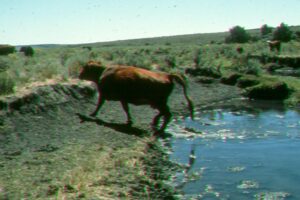
Livestock are a major source of water pollution throughout the West. Photo George Wuerthner.
Cattle, in particular, produce a large amount of manure that is a major source of water pollution (Javier Mateo-Sagasta et al. 2017).
Cattle destroy biocrusts, particularly in arid ecosystems, fostering the spread of weeds and exotic plants like cheatgrass (Reisner, Michael D., et al., 2013: Zaady E., Eldridge D.J., Bowker M.A., 2016; Root et al. 2019).
Cattle trample riparian areas in arid ecosystems that are critical habitats for 70-80% of all wildlife (Dobkin, D.S., A. C. Rich, and W. H. Pyle, 1998).
Cattle hooves compact soils, reducing the infiltration of water (Warren, S.D. et al., 1986; Belsky, J.A., A. Matzke, and S. Uselman, 1999).
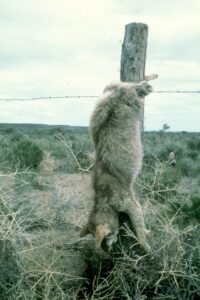
Coyote hung on a fence as a “warning” to other predators. Predator control is one of the unaccounted costs of livestock production. Photo George Wuerthner.
In most of the world, protecting livestock from predators is one of the primary factors contributing to many predator species’ decline and endangerment (Treves, A. et al., 2019; Tyler B. Muhly ⁎, Marco Musiani. (2009).
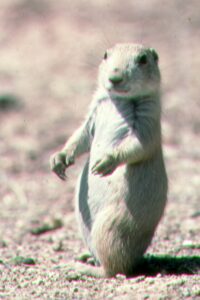
“Pests” such as prairie dogs are indiscriminately poison, shot, and even burned out of their burrows by livestock interests. Photo George Wuerthner.
Livestock presence is the main justification for the destruction of “pests” like native ground squirrels and prairie dogs (Miller et al., 2000). Which in turn precludes recovery of endangered species like black-footed ferret (Miller et al. 1990).
The growing of forage for livestock is a significant reason tropical forests are cleared (for hay and soy production,) with a sequent loss of carbon to the atmosphere. It is also the reason for much of the destruction of native vegetation in places like the Midwest of the U.S., where livestock forage crops like corn and soy dominate (Nickerson, Cynthia, and Allison Borchers. 2012).
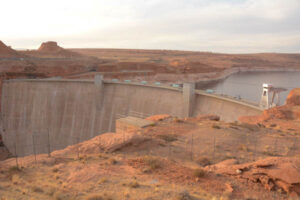
Dams built across the West store water for irrigation, much of it producing livestock forage, block fish migration, and changes water flows to the detriment of aquatic ecosystems. Photo George Wuerthner.
Since much of the hay/alfalfa grown in the arid West requires irrigation, the impoundment of rivers with dams is another consequence of livestock production (Wuerthner G. and M. Matteson eds. 2002; Hanson, Brian. 2020).
Grazing can also alter plant communities, with ecological consequences not only for livestock production but also for wildlife. For instance, a heavily grazed shortgrass steppe in Colorado shifted from mixed prairie with cool-season plants to a plant community dominated by the warm-season grass blue grama. This shift in plant species reduces the available forage earlier in the season, which can affect livestock productivity, but also has obvious impacts on native wildlife that may depend on early green-up of cool-season grasses (LeCain et al. 2004).
In yet another study in New Mexico, grazing shifted grasslands to mesquite. The deep-rooted mesquite had far more carbon storage than the grasslands. However, many ecologists see the shift to mesquite as a degraded ecosystem (Bird, S.B. et al. 2002). Livestock grazing can also shift vegetation from native bunchgrass to more fire-prone exotics like cheatgrass (Condon Lea and David Pyke. 2018).
Livestock grazing is one of the chief causes of species endangerment (Wilcove, David, et al. 1998; Flather, C.H. L.A. Joyce and C.A. Bloomgarden. 1994).
The mere presence of domestic livestock can displace native ungulates like elk (Clegg, Kenneth. 1994: Stewart, Kelly, et al., 2002).
Trampling by livestock hooves can impact native mollusks (snails) which are an important decomposer in arid land communities (Freist, Terrence.J. 2002; Denmead, Lisa H., et al., 2015).
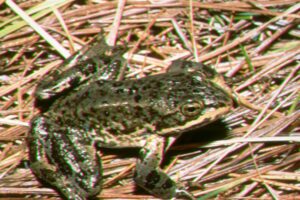
Frogs and other amphibians are impacted when livestock trample springs or remove water with pipelines from wetlands and springs. Photo George Wuerthner.
Cattle grazing and trampling of wetlands and springs can negatively impact amphibians (Engle, Janice. 2002).
The fences required for cattle distribution and control can be deadly for wildlife (Jakesa, A., et al. 2018). Fences, for instance, are responsible for significant mortality for sage grouse (Gruver, Mead, 2009).
Grazing, particularly in arid landscapes, can impact soil biochemical processes (Fernandez, D.P, J.C. Neff, R.L. 2008).
Globally, conversion of native plant communities to cattle operations can significantly reduce carbon sequestration (Kauffman et al. 2017).
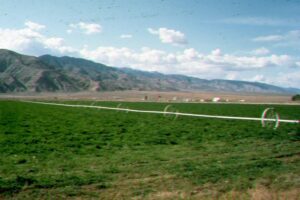
Irrigated hay field in Fish Creek Valley, Nevada. Irrigation for livestock forage is the biggest consumer of water in the West resulting in dewatering of aquatic ecosystems. Photo George Wuerthner.
Most western livestock production relies on irrigated hay fields to produce additional forage, and dewatering has significant impacts on aquatic ecosystems and stream flows (Hanson, Brian. 2020)
Livestock are also a major vector for the transport of invasive species seeds (Hogan J. P and Phillips C. J. C. , 2011), particularly of cheatgrass (Root, Heather et al., 2019).
The majority of native fish in the West face extinction or severely diminished range and numbers, primarily due to livestock-induced habitat damage or dewatering for livestock feed (Minckley, W.L., and J.E. Deacon. 1991; Richter, B.D. et al., 2020).
Enclosures tended to have a more diverse flora, including more forbs (flowers) and cool-season grasses. In particular, the presence of forbs may be necessary to pollinating insects like butterflies and flies, and the effects on total biodiversity should be considered, not just whether there are greater soil carbon accumulations (Reeder, J.D. and G.E. Schuman. 2001).
Though many suggest domestic cattle have replaced native bison, there are significant ecological differences in behavior, habitat use, and forage utilization (Wuerthner, George, 2002a)
Thus, focusing on carbon storage without considering other ecosystem values may be counterproductive.
GRASS-FED BEEF
Grass-fed beef is not a panacea either, as grass is nutritionally inferior and requires greater transit time in the cow’s rumen, resulting in anywhere from 2-4 times as much methane production (Pieper, et al. 2020). For instance, one study reported a 48% increase in methane production by cows feeding on natural grasslands (Grobler, S.M. et al. 2014). In another study comparing CAFO farmed animals with natural pasture feed cattle, the grass-fed beef had significantly greater methane emissions (Pelletier, N. et al. 2010).
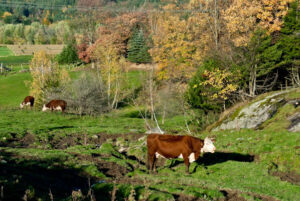
Cattle grazing in Vermont. Most eastern pastures were created by the removal of forest cover. Forests store far more carbon than the pasturelands that replaced them. Photo George Wuerthner.
Furthermore, any increase in cattle production (as advocated by Allan Savory and others) would likely come at the expense of forests, since most new livestock pasturage is carved from forested landscapes. (Most natural grasslands are already under livestock production and have little space available for increasing animal numbers.) Since forests capture and store far more carbon than any grassland pastures that replace them, expanding livestock production would likely result in a net loss in carbon storage.
https://www.theguardian.com/environment/2020/dec/23/organic-meat-production-just-as-bad-for-climate-study-finds?CMP=Share_iOSApp_Other
In their assessment of the full life cycle estimate of GHG emissions attributable to livestock (which includes collateral impacts like forest clearing), Goodland and Anhang suggest that nearly 51% of the annual worldwide anthropogenic GHG emissions are attributable to livestock (Goodland and Anhang, 2009).
A reduction in livestock numbers and production would permit the potential reforestation of millions of acres of land cleared for livestock pasture (Nickerson, Cynthia, and Allison Borchers. 2012). This would effectively store far more carbon than livestock grazing could achieve through any stimulation of plant production and SOC storage (Goodland, Robert. January 2014).
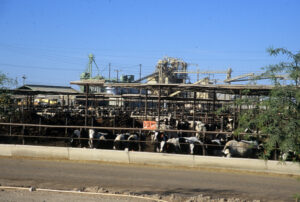
Factory farming like this operation in California has many negative impacts, but compared to grass-fed beef, Greenhouse Gas Emissions are lower. Photo George Wuerthner.
A review by Capper (2012) concluded that: “Conventional beef production (finished in feedlots with growth-enhancing technology) required the fewest animals and least land, water and fossil fuels to produce a set quantity of beef. The carbon footprint of conventional beef production was lower than that of either natural (feedlot finished with no growth-enhancing technology) or grass-fed (forage-fed, no growth-enhancing technology) systems.”
SUMMARY
There is no clear evidence that livestock grazing can significantly enhance soil carbon stores. Conflicting evidence exists that demonstrates greater carbon storage with no grazing, while in other ecosystems, grazing may enhance soil carbon under specific grazing management. But there are many cautionary remarks on how to measure and interpret findings.
Climatic conditions year to year, for instance, can shift carbon storage in grazed areas from a positive to a negative. Furthermore, any storage is gradual and takes years to accumulate, while carbon uptake by soils is finite and slows over time.
And compared to almost all other ecosystems, arid rangelands are among the least productive ecosystems—hence have little potential for soil carbon storage compared to different ecosystems like forests.
Because of this time factor and the need to reduce CO2 levels now, the use of rangelands as a carbon sink—even if it were proven effective—is a flawed strategy for a host of reasons. One cannot look at the soil carbon storage issue out of context. Livestock are among the most significant source of GHG emissions now—and reducing livestock numbers is the quickest and perhaps the most effective means of significantly altering GHG emissions (Ripple, W. et al. 2014).
Furthermore, there are a host of collateral damages created by livestock production, from the destruction of soil biocrusts, killing of predators, water pollution, clearing of forests for pasture, and other ecological impacts. Taken as a whole, the production of livestock has many significant negative ecological effects, not the least of which is its contribution to global GHG emissions and in most cases, a reduction in soil carbon sequestration.
REFERENCES:
Belsky, Joy A., et al., 1993. Overcompensation by or red herring? Evolutionary Ecology, 1993, 7, 109-121
Belsky, Joy, and Dana M. Blumenthal, 1997. Effects of Livestock Grazing on Stand Dynamics and Soils in Upland Forests of the Interior West Conservation Biology, Pages 315-327 Volume 11, No. 2, April 1997
Belsky, Joy A. Allan Savory’s Holistic Management: Scientific Misinformation on Grazed Ecosystems. Unpublished manuscript, Archive of Joy Belsky Papers.
Belsky, A.J., and J. L. Gelbard, 2000. Livestock Grazing and Weed Invasions in the Arid West, Oregon Natural Desert Association, Bend, Ore, USA, 2000.
Belsky, J.A., A. Matzke, and S. Uselman, 1999. “Survey of livestock influences on stream and riparian ecosystems in the western United States,” Journal of Soil and Water Conservation, vol. 54, no. 1, pp. 419–431, 1999
Beschta, R.L., D. L. Donahue, A. DellaSala et al., 2012 .“Adapting to climate change on western public lands: addressing the ecological effects of domestic, wild, and feral ungulates,” Environmental Management, vol. 51, no. 2, pp. 474–491, 2012.
Bird, S.B. et al., 2002 Spatial heterogeneity of aggregate stability and soil carbon in semi-arid rangelands. Environmental Pollution 116 pages 445-455
Bao-Long, Yan, WANG Zhong-Wu*, QU Zhi-Qiang, WANG Jing, and HAN Guo-Dong, 2018. Effects of enclosure on carbon density of plant-soil system in typical steppe and desert steppe in Nei Mongol, China. Chinese Journal of Plant Ecology 2018, 42(3): 327–336
Booker, Kayle, et al., 2013. What can ecological science tell us about opportunities for carbon sequestration on arid rangelands in the United States? Global Environmental Change Volume 23, Issue 1, February 2013, Pages 240-251
Bradley BA, Curtis CA, Fusco EJ, Abatzoglou JT, Balch JK, Dadashi S, Tuanmu M-N. 2017. Cheatgrass (Bromus tectorum) distribution in the intermountain Western United States and its relationship to fire frequency, seasonality, and ignitions. Biological Invasions. https://dx.doi.org/10.1007/s10530-017-1641-8
Briske, D. et al., 2014. The Savory Method cannot green deserts or reverse climate change. A response to Allan Savory’s TED video. Rangelands 35(5):72–74 doi: 10.2111/RANGELANDS-D-13-00044.1
Briske, David, Brandon T. Bestelmeyer, and Joel R. Brown. 2014. Savory’s Unsubstantiated Claims Should Not Be Confused With Multi paddock Grazing. Rangelands
Carter, John, Allison Jones, Mary O’Brien, Jonathan Ratner, and George Wuerthner, 2014. Holistic Management: Misinformation on the Science of Grazed Ecosystems. International Journal of Biodiversity Volume 2014, Article ID 163431, 10 pages
Catlin, James C., John G. Carter, and Allison L. Jones. 2011.Range Management in the Face of Climate Change Natural Resources and Environmental Issues: Vol. 17, Article 24.
Chamane, Sindiso; Kevin Kirkman, Craig Morris, and Tim O’Connor. 2016. Effects of Short Duration, High-Density Stocking on Soil Properties and Plant Species Composition of a Mesic Grassland in South Africa. https://www.researchgate.net/publication/30717364
Cheng, J. et al. Cumulative effects of 20-year exclusion of livestock grazing on above and below-ground biomass of typical steppe communities in arid areas of the Loess Plateau, China. Plant Soil Environ. 57, 2011 (1): 40–44
Clapper, J. 2012 Is the Grass Always Greener? Comparing the Environmental Impact of Conventional, Natural and Grass-Fed Beef Production Systems. Animals 2012, 2, 127-143; doi:10.3390/ani2020127.
Clegg, Kenneth. 1994. Density and Feeding Habits of Elk and Deer in Relation to Livestock Disturbance Master of Science Utah State University.
Condon Lea and David Pyke. 2018. Fire and Grazing Influence Site Resistance to Bromus tectorum Through Their Effects on Shrub, Bunchgrass and Biocrust Communities in the Great Basin (USA) https://link.springer.com/article/10.1007/s10021-018-0230-8
Cooper et al. 2018. Livestock grazing and aridity reduce the functional diversity of biocrusts. Plant Soil (2018) 429:175–185. DOI 10.1007/s11104-017-3388-5
Daryantoa, Stephan, David J. Eldridge, Heather L. Throop, 2013. Managing semi-arid woodlands for carbon storage: Grazing and shrub effects on above- and belowground carbon. Agriculture, Ecosystems and Environment 169 (2013) 1– 11
Denmead, Lisa H., et al., 2015. Experimental evidence that even minor livestock trampling has severe effects on land snail communities in forest remnants. Journal of Applied Ecology 2015, 52, 161–170
Derner, Justin D., David J. Augustine, and Douglas A. Frank, 2018. Does Grazing Matter for Soil Organic Carbon Sequestration in the Western North American Great Plains? Ecosystems https://doi.org/10.1007/s10021-018-0324-3
Diamond, Joel, Christopher A. Call, and Nora Devoe. 2009. Effects of targeted cattle grazing on fire behavior of cheatgrass-dominated rangeland in the northern Great Basin, USA International Journal of Wildland Fire 2009, 18, 944–950
Dingpeng Xionga, Peili Shia, Xianzhou Zhanga, Chris B. Zou. 2016. Effects of grazing exclusion on carbon sequestration and plant diversity in grasslands of China—A meta-analysis. Ecological Engineering 94 (2016) 647–655
Dobkin, D.S., A. C. Rich and W. H. Pyle, 1998. “Habitat and avifaunal recovery from livestock grazing in riparian meadow system of the northwestern Great Basin,” Conservation Biology, vol. 12, no. 1, pp. 209–221, 1998
Dormaar, Johan F., Smoliak, S. & Walter D. Willms, 1989. Vegetation and Soil Responses to Short-Duration Grazing on Fescue Grasslands. Journal of Range Management, 42(3), pp.252–256.
Engle, Janice. 2002. Silent Springs: Threats to Frog Habitat from Livestock Production. Welfare Ranching: The Subsidized Destruction of the American West. Island Press. Washington DC.
Fang Fei, Chang Rui-ying1, Tang Hai-ping. 2014. Effects of Grazing on Carbon Sequestration in Temperate Grassland, Inner Mongolia of North China Vegetos- An International Journal of Plant Research Volume: 27, Issue : 3 pgs. 126-134.
Fernandez, D.P, J.C. Neff, R.L. 2008. Reynolds Biogeochemical and ecological impacts of livestock grazing in semi-arid southeastern Utah, USA. Journal of Arid Environments 72 (2008) 777–791
Flather, C.H. L.A. Joyce and C.A. Bloomgarden. 1994.Species Endangerment Patterns in the United States. USDA Forest Service General Technical Report RM-241. Rocky Mountain Research Station, Fort Collins, CO.
Fleischner, Thomas. 1994. Ecological Costs of Livestock Grazing on Western North America. Conservation Biology 8, no. 3629-644.
Freilich et al., 2003. Ecological Effects of Ranching: A Six-Point Critique. August 2003 / Vol. 53 No. 8 • BioScience 759
Freist, Terrence.J. 2002. Native Snails: Indicators of Ecosystem Health. Welfare Ranching: The Subsidized Destruction of the American West.
FAO, Livestock’s Long Shadow. Environmental Issues and Options (Rome, Italy: Food and Agriculture Organization of the United Nations, 2006).
FAO. Livestock’s Long Shadow. Livestock role in water depletion and pollution. (Rome, Italy: Food and Agriculture Organization of the United Nations, 2006).
Frank, A.B. et al., 1995. Soil carbon and nitrogen of Northern Great Plains grasslands as influenced by long-term grazing. J. Range Management. 48: 470-474.
Gao. Y.H. et al., 2007. Grazing intensity impacts on carbon sequestration in an alpine meadow of the eastern Tibetan Plateau. Research Journal of Agriculture and Biological Sciences, 3(6): 642-647, 2007
Goodland, R Anhang, J (2009) Livestock, and Climate Change: What if the key actors in climate change were pigs, chickens, and cows? World Watch, November/December 2009. Worldwatch Institute, Washington, DC, USA. Pp. 10–19. Available at: http://www.worldwatch.org/files/pdf/Livestock%20and%20Climate%20Change.pdf
Goodland, Robert. 2013. A fresh look at livestock greenhouse gas emissions and mitigation potential in Europe World Bank, 1818 Society, 1818 H Street NW, Washington, Washington DC 20433 http://onlinelibrary.wiley.com/doi/10.1111/gcb.12454/abstract
Goodland, Robert. January 2014. Happier Meals. Climate Alert. Climate Institute. http://www.climate.org/publications/Climate%20Alerts/2014-january/happier-meals.html
Grobler, S.M. et al., 2014. Methane Production in different breeds, grazing different pastures or fed a total mixed ration as measures by a Laser Methane Detector. South African Journal of Animal Science 2014, 44 (Issue 5, Supplement 1)
Gruver, Mead, 2009. Report: Barbed-wire fences deadly to sage grouse. https://trib.com/news/state-and-regional/article_719fe71a-88a3-57f2-87c7-1ebfc00edf71.html
Hanson, Brian. 2020. Irrigation of Agricultural Crops in California. Department of Land, Air and Water Resources University of California, Davis brhanson@ucdavis.edu
Hawkins, Heidi-Jayne. 2017. A global assessment of Holistic Planned Grazing compared with season-long, continuous grazing: meta-analysis findings. http://www.tandfonline.com/loi/tarf20
Hogan J. P., Phillips C. J. C., 2011. Transmission of weed seed by livestock: a review. Animal Production Science 51, 391-398.
Holechek, Jerry, et al., 2000. Short-Duration Grazing: The Facts in 1999. RANGELANDS 21(5) https://doi.org/10.1071/AN10141
Hudak, Mike, 2015. Claims that Livestock Grazing Enhances Soil Sequestration of Atmospheric Carbon Are Outweighed by Methane Emissions From Enteric Fermentation: A Closer Look at Franzluebbers and Stuedemann (2009). www.mikehudak.com
IPBES (2019): Global assessment report on biodiversity and ecosystem services of the Intergovernmental Science-Policy Platform on Biodiversity and Ecosystem Services. E. S. Brondizio, J. Settele, S. Díaz, and H. T. Ngo (editors). IPBES secretariat, Bonn, Germany.
Ingram L.J. et al., 2008. Grazing impacts on soil carbon and microbial communities in a mixed-grass ecosystem. Soil Sci. Soc. Am. J. 72:939-948
Jakes, A., et al., 2018. A fence runs through it: A call for greater attention to the influence of fences on wildlife and ecosystems. Biological Conservation 227 (2018) 310–318
Jamus, Joseph, et al., 2002. Short Duration Grazing Research in Africa An extensive review of the Charter Grazing Trials and other short-duration grazing studies on African rangelands. RANGELANDS 24(4)
Jones, Allison, 2002. Surveying the West—A Summary of Research on Livestock Impacts. Welfare Ranching: The Subsidized Destruction of the West. Island Press, Washington DC.
Kauffman, B., W. C. Krueger, and M. Vavra, 1983. “Effects of late-season cattle grazing on riparian plant communities,” Journal of Range Management, vol. 36, no. 6, pp. 685–691, 1983.
Kauffman B. and W. C. Krueger.,1984. Livestock Impacts on Riparian Ecosystems and Streamside Management Implications: A Review JOURNAL OF RANGE MANAGEMENT 37(5), September 1984
Kauffman, B., Virni B Arifanti, Humberto Hernández Trejo, Maria del Carmen Jesús García, 2017. The jumbo carbon footprint of a shrimp: carbon losses from mangrove deforestation. Front Ecol Environ 2017; doi:10.1002/fee.1482
Jennifer Norfolk3, Miguel Cifuentes4, Deddy Hadriyanto5, and Daniel Murdiyarso6,7
Klumpp, K., Fontaine, S., Attard, E., Le Roux, X., Gleixner, G. and Soussana, J.-F. (2009), Grazing triggers soil carbon loss by altering plant roots and their control on soil microbial community. Journal of Ecology, 97: 876–885. DOI: 10.1111/j.1365-2745.2009.01549.
LeCain et al., 2004. Carbon exchange and species composition of grazed pastures and exclosures in the shortgrass steppe of Colorado. Agriculture, Ecosystems, and Environment 93 (421-435.
Mack Richard N. and John N. Thompson, 1982. Evolution of the Steppe with few large, hoofed mammals. The American Naturalist. Vol 19. No. 6.
Mateo-Sagasta, Javier et al., 2017. Water pollution from agriculture: a global review. the Food and Agriculture Organization of the United Nations Rome, 2017 and the International Water Management Institute on behalf of the Water Land and Ecosystems research program.
McGuire. Andrew, 2018. Washington State University http://csanr.wsu.edu/regen-ag-solid-principles-extraordinary-claims/ @inproceedings{Nordborg2016HolisticM, title={Holistic management – a critical review of Allan Savory’s grazing method.},author={M. Nordborg and E. R{\”o}{\”o}s},year={2016} https://regenerationinternational.org/2017/02/24/what-is-regenerative-agriculture/
McSherry, M., and Mark Richie, 2013. Effects of grazing on grassland soil carbon: a global review. Global Change Biology (2013) 19, 1347–1357, DOI: 10.1111/gcb.12144
Meyers, S., 2011. Is climate change mitigation the best use of desert shrublands? Natural Resources and Environmental Issues: Vol. 17, Article 2. Available at: http://digitalcommons.usu.edu/nrei/vol17/iss1/2
Miller et al., 1990. A proposal to protect the Black-footed ferret and the Prairie Dog Ecosystem. Environmental Management Vol. 14, No. 6 pp 763-769.
Miller et al., 2000. The Role of Prairie Dogs as a Keystone Species: Response to Stapp. Conservation Biology, Pages 318-321 Volume 14, No. 1, February 2000
Minckley, W.L., and J.E. Deacon, 1991. Battle Against Extinction: Native Fish Management in the West. U of Arizona Press
Myers, Bruce, 2014. Livestock’s Hoof Print-the Challenge of Regulating Global Warming Emissions. Environmental Law Institute, Policy Brief 8.
Nickerson, Cynthia and Allison Borchers. 2012. How Is Land in the United States Used? A Focus on Agricultural Land. Economic Research Service United States Department of Agriculture.
Nordborg, M., 2016. A critical review of Allan Savory’s grazing method. SLU/EPOK – Centre for Organic Food & Farming & Chalmers. Available at: http://publications.lib.chalmers.se/records/fulltext/244566/local_244566.pdf.
Nobari. Massim, 2018. https://seedthecommons.org/a-call-to-counter-the-false-solution-of-regenerative-grazing/
Pelletier, N. et al., 2010. Comparative life cycle environmental impacts of three beef production strategies in the Upper Midwestern United States. Agricultural System 103 (2010) 380–389.
Pieper, Maximilian, Amelie Michalke2 & Tobias Gaugler, 2020. Calculation of external climate costs for food highlights inadequate pricing of animal products. NATURE COMMUNICATIONS | https://doi.org/10.1038/s41467-020-19474-6
Pils, A. and J. Wilder, 2018. Risk Analysis of Disease Transmission between Domestic Sheep and Goats and Rocky Mountain Bighorn Sheep. USDA Forest Service, Shoshone National Forest.
Qiu, L. et al., 2013. Ecosystem carbon and nitrogen accumulation after grazing exclusion in a semiarid grassland. PLOS ONE | www.plosone.org 1 January 2013 | Volume 8 | Issue 1
Reeder, J.D., and G.E. Schuman, 2001. Influence of livestock grazing on C sequestration in semi-arid mixed grass and short grass rangelands. Environmental Pollution, 116 457-463.
Reisner, Mark, and Sarah Bates, 1990. Overlapped Oasis: Reform or Revolution for Western Water. Island Press, Washington DC.
Reisner, Michael D. et al., 2013. Conditions favouring Bromus tectorum dominance of endangered sagebrush steppe ecosystems. Journal of Applied Ecology 2013
Richter, B.D. et al., 2020. Water scarcity and fish imperilment driven by beef production. Nature Sustainability. https://doi.org/10.1038/s41893-020-0483-z
Ripple, W. J., & Beschta, R. L. ,2012. Large predators limit herbivore densities in northern forest ecosystems. European Journal of Wildlife Research. doi:10.1007/s10344-012-0623-5
Ripple, W. et al., 2014. Ruminants, Climate Change, and Climate Policy. Nature Climate Change Vol. 3 www.nature.com/natureclimatechange
Root, Heather et al., 2019. Grazing disturbance promotes exotic annual grasses by degrading soil biocrust communities. Ecological Applications, 0(0), 2019, e02016
Savory, A., and S. D. Parsons, 1980.“The Savory grazing method, “Rangelands, vol. 2, pp. 234–237, 1980.
Savory, A., 1983, “The Savory grazing method or holistic resource management,” Rangelands, vol. 5, pp. 155–159, 1983.
Savory, A., 1988. Holistic Resource Management, Island Press, Washington, DC, USA, 1988.
Savory, A., and J. Butterfield,1999. Holistic Management: A New Framework for Decision Making, Island Press, Washington, DC, USA, 1999
Savory, A., 2013. How to fight desertification and reverse climate change. https://www.ted.com/talks/allan_savory_how_to_fight_desertification_and_reverse_climate_change/transcript?language=en
Schieltz and Rubenstein, 2016. Evidence based review: positive versus negative effects of livestock grazing on wildlife. What do we really know? Environmental Research Letters, 10.1088/1748-9326/11/11/113003.
Schuman,G.E., H.H. Janzen, J.E. Herrick, 2001. Soil carbon dynamics and potential carbon sequestration by rangelands. Environmental Pollution 116 (2002) 391–396
Shao, C. et al., 2013. Grazing alters the biophysical regulation of carbon fluxes in a desert steppe. Environ. Res. Lett. 8 (2013) 025012 (14pp)
Shovlin, Jon, 1987. “Southern Africa’s Experience with Intensive Short Duration Grazing.” Rangelands. 9 (4): 162–167.
Sommer R. and D Brossio. 2014. Dynamics and climate change mitigation potential for soil carbon sequestration J of Environmental Management 144 pgs. 83-87.
Steinfeld, H. et al., 2006. Livestock’s Long Shadow. U.N. Food and Agricultural Organization. http://www.fao.org/docrep/010/a0701e/a0701e00.HTM
Stewart, Kelly, et al., 2002. Temporal spatial distribution of elk, mule deer, and cattle. Resource partitioning and competitive displacement. Journal of Mammalogy, 83(1):229–244, 2002
Sundt, Peter, 2013. The Ecological Ideas of Alan Savory: A Literature Review Report to Animas Foundation.
Talore, D. G., Eyob H. Tesfamariam, A. Hassen J. C. O. Du Toit, Katja Klumpp & J. F. Soussana, 2015. Long-term impacts of season of grazing on soil carbon sequestration and selected soil properties in the arid Eastern Cape, South Africa. Plant Soil DOI 10.1007/s11104-015-2625-z
Treves, A. et al., 2019. Predator Control Needs a Standard of Unbiased Randomized Experiments With Cross-Over Design. Front. Ecol. Evol., 12 December 2019 | https://doi.org/10.3389/fevo.2019.00462
Tyler B. Muhly ⁎, Marco Musiani, 2009. Livestock depredation by wolves and the ranching economy in the Northwestern U.S. Ecological Economics 68 (2009) 2439–2450
Wang, x. et al., 2015.Methane uptake and emissions in a typical steppe grazing system during the grazing season. Atmospheric Environment, Vol. 105, pgs. 14-21.
Wang, Dong, Gao-LinWua,b, Yuan-Jun Zhua,b, Zhi-Hua Shi, 2014. Grazing exclusion effects on above- and below-ground C and N pools of typical grassland on the Loess Plateau (China) Catena 123 (2014) 113–120
Warren, S.D. et al., 1986. The Influence of Livestock Trampling under Intensive Rotation Grazing on Soil Hydrologic Characteristics. JOURNAL OF RANGE MANAGEMENT 39(6). November 1966
Wilcove, David, et al., 1998. Quantifying Threats to Imperiled Species in the United States. Bioscience 607-613.
Williamson, Matt. A. et al., 2019. Fire, livestock grazing, topography, and precipitation affect the occurrence and prevalence of cheatgrass (Bromus tectorum) in the central Great Basin, USA Biol Invasions https://doi.org/10.1007/s10530-019-02120-8(0123456789().,-vols() 0123458697().,-vol V)
Wuerthner, George, and Mollie Matteson. 2002. Welfare Ranching: The Subsidized Destruction of the West. Island Press. Washington DC.
Wuerthner, George, 2002a. Just Domestic Bison? Cattle are no Substitute for Buffalo. Welfare Ranching: The Subsidized Destruction of the American West. Island Press. Washington DC.
Wuerthner, George, 2002b. The Donut Diet, The Too Good To Be True Claims of Holistic Management. Welfare Ranching: The Subsidized Destruction of the American West. Island Press, Washington DC.
Zaady E., Eldridge D.J., Bowker M.A., 2016. Effects of Local-Scale Disturbance on Biocrusts. In: Weber B., Büdel B., Belnap J. (eds) Biological Soil Crusts: An Organizing Principle in Drylands. Ecological Studies (Analysis and Synthesis), vol 226. Springer, Cham. https://doi.org/10.1007/978-3-319-30214-0_21
Zhang, Yi, Yingzhong Xie, Hongbin Ma, Le Jing, Cory Matthew and Jianping, 2019. Rebuilding soil organic C stocks in degraded grassland by grazing exclusion: a linked decline in soil inorganic C
The post Grazing and Climate Change: the Influence of Livestock on Soil Carbon Storage appeared first on CounterPunch.org.
